
If you’ve ever been met with an eye roll, a slammed door, or the dreaded “whatever,” you know that parenting a teenager is no easy task. But for teens in care, conflict isn’t just about independence—it’s a test of trust and security.
Click the blue button below to Download the Guide
What looks like defiance is often a survival response—a way to protect themselves from disappointment. But with the right approach, you can turn difficult moments into opportunities for connection and resilience-building.
Caring for a Teen in Care Comes with Unique Challenges
Many fostered young people have learned that conflict means rejection or abandonment. They may be asking themselves:
Why Do Simple Requests Lead to Big Reactions?
Teenagers process stress differently from adults. Their brains are still developing, making emotions more intense and reasoning skills harder to access in the moment.
Common Triggers That Lead to Conflict:
Traditional discipline can often trigger shame, increase defensiveness, and damage trust—but by understanding their emotional world, you can help them feel safe enough to grow and thrive.
In this downloadable resource, you’ll learn:
Click the blue button below to Download the Guide
Our goal is to enhance quality of life for everyone with a compelling emphasis on the benefits of healthy, therapeutic relationships.